|
[start]
|
documentary.de nicht-digitale fotografie
|
Ruanda |
|
"Rwanda
was an assignment for Doctors without Borders / Médecins sans Frontières.
I visited numerous refugeecamps in south and central Rwanda. The
selection shows various aspects of refugee life and gives a short overview
on the political background."
|
| History
From the 16th century to 1959 the Tutsi kingdom of Rwanda shared the
history of Burundi. In 1959 an uprising of the Hutu destroyed the Tutsi
feudal hierarchy and led to the departure of the Mwami Kigeri V. Elections |
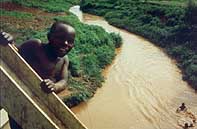 |
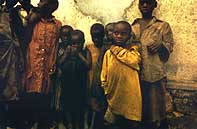 |
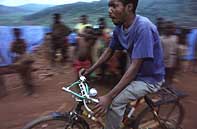 |
| Area and Population
Rwanda is bounded south by Burundi, west by the Democratic Republic of Congo, north by Uganda and east by Tanzania. A mountainous state of 26,338 sq. km, its western third drains to Lake Kivu on the border with Zaire and thence to the Congo river, while the rest is drained by the Kagera river into the Nile system. The population is about 8-9 Million consisting over 90% of Hutu, 9% Tutsi and 1% Twa (pygmy). |
Climate
Despite the equatorial situation, there is a highland tropical climate. The wet seasons are from Oct. to Dec. and March to May. Highest rainfall occurs in the west, at around 1,770 mm, decreasing to 1.400 mm in the central uplands and to 760 mm in the north and east. Jan 19.4 C (670F), July 21.1 C (700F). |
| International Relations
Rwanda is a member of the UN, OAU and is an ACP state of the EEC. With Burundi and the D.R. Congo it formed part of the Economic Community of Countries of the Great Lakes. Subsistence agriculture accounts for most of the gross national product. Staple food crops are sweet potatoes, cassava dry beans, maize, peas and groundnuts. The main cash crops are aravica coffee, tea and pyrethrum. |
Religion and Language
Religion. The population is predominantly Roman Catholic (56%); there is an archbishop (Kigali) and 3 bishops. 23% of the population follow traditional religions, 12% are Protestants and 9% Moslems. Kinyarwanda, the language of the entire population, and French are official languages, and Kiswahili is spoken in the commercial centers. |
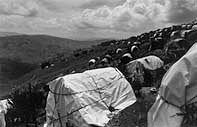 Rwanda
is a very green lush country of rolling hills and valleys. There hardly
appears to be any flat space anywhere. Everywhere in the hills are banana
trees, avocado trees, a patchwork of cultivated fields of sweet potato and
all sorts of crops. The valleys are emerald green with rice paddies and
irrigation canals. The temperature is perfect at this altitude and there
is a short rainfall every afternoon. Rwanda
is a very green lush country of rolling hills and valleys. There hardly
appears to be any flat space anywhere. Everywhere in the hills are banana
trees, avocado trees, a patchwork of cultivated fields of sweet potato and
all sorts of crops. The valleys are emerald green with rice paddies and
irrigation canals. The temperature is perfect at this altitude and there
is a short rainfall every afternoon.
The atmosphere in general has been destabilized by the events in Burundi and the massive influx of refugees in the south. |
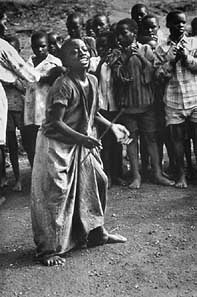 |
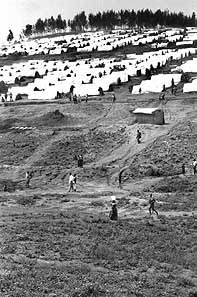 |
Hundreds of thousands of people 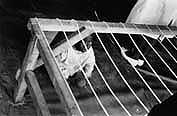 fled the ghastly inter-ethnic massacres in Burundi that followed the murder
of the country's president in October 1993. About 700,000 of them live in
refugee camps in the south of Rwanda.
fled the ghastly inter-ethnic massacres in Burundi that followed the murder
of the country's president in October 1993. About 700,000 of them live in
refugee camps in the south of Rwanda.
In Kagina there are 25,000 people on one hillside. The long low traditional shelters built with branches and reeds are all covered with white plastic sheeting from UNHCR. The shelters, called 'blendays' are spaced just a few feet apart and each one is shared by two families who may not even know each other. |
| The camps are cesspools of death and disease. Poor sanitation,
inadequate food and overcrowding make the refugees particularly vulnerable
to dysentery and other infectious diseases . Malaria also is a problem,
especially during the rainy season.
|
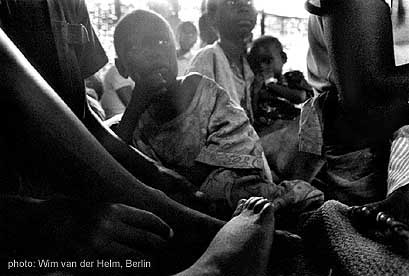 |
| The death rate at the camps in Rwanda is about five per 10,000 people per day. That is five times the normal rate for such camps. Young children make up a disproportionate share of the dead. | |
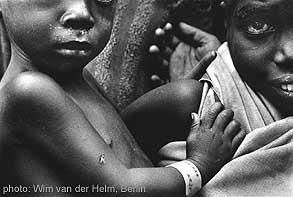 |
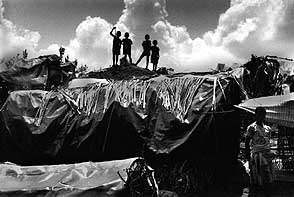 |
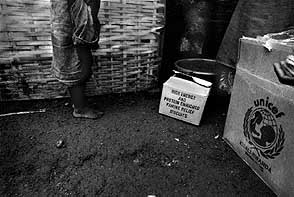 |
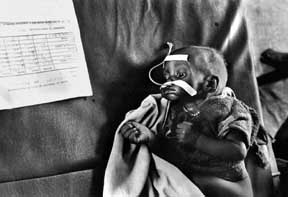 |
| Medecins sans Frontieres / Doctors without Borders provides medical aid in the refugee camps and is improving the sanitary facilities. Undernourished children receive supplementary food. | ||
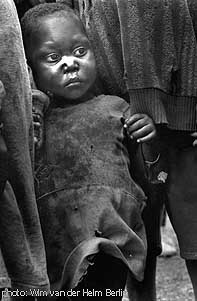 |
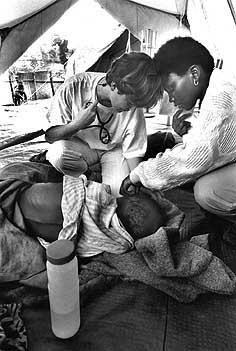 |
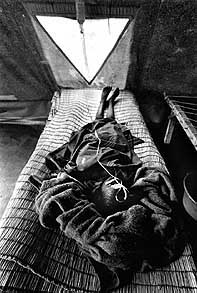 |
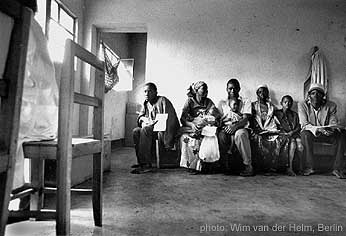 |
Epidemics of dysentery and malaria are raging through the camp and the
dispensary is seeing more than 500 patients per day.
Grown men and women are so weak from malnutrition, fever and dehydration that they cannot raise their heads to drink. Every night one or two people die in the dispensary. |
| At the moment they receive just one meal a day of biscuits and a small
bowl of porridge. The lucky ones might get a few sardines.
A morbidity |
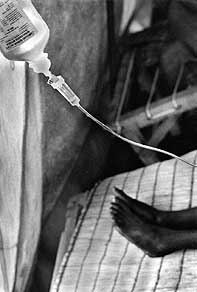 |
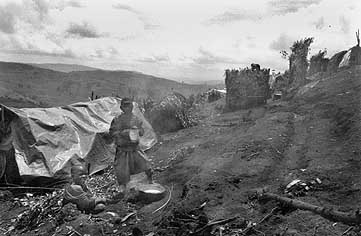
A lab study done a couple of weeks ago showed that 40% of dysentery cases seen in a small sample of dispensary patients also had blood smears positive for malaria (mostly falciparum). The camp is situated right next to a swamp and the medical coordinator decided to change the protocols so that all dysentery cases also receive a course of treatment for malaria. |
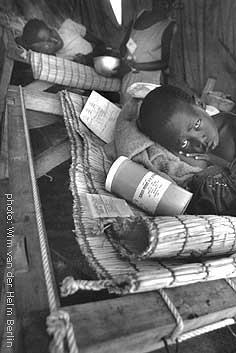 |
 The
local team from Doctors without Borders consists of 10 expatriates and 570
local personnel. This includes all the water and sanitation people, construction
workers, community health workers, drivers, guards, cooks and so on. The
local team from Doctors without Borders consists of 10 expatriates and 570
local personnel. This includes all the water and sanitation people, construction
workers, community health workers, drivers, guards, cooks and so on.
Altogether in Rwanda MSF-Holland has 29 expatriates. In the south of Rwanda there are many other NGO's and UN organizations working in a dozen or more camps for hundreds of thousands of refugees. |
|
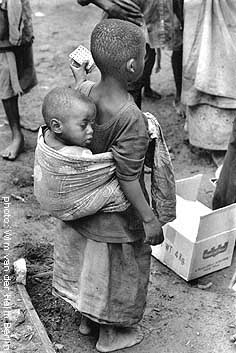 |
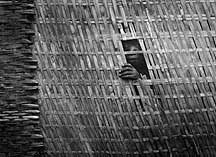
The UN World Food Program initially allocated rations of 1,400 calories a day to the Burundians. The aim was to prevent food being diverted and sold. Relief agencies complained and the ration was increased to a barely adequate 1,900 calories a day. But people seem only to be actually receiving half of this in the end. |
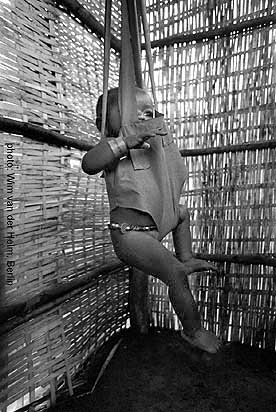 |
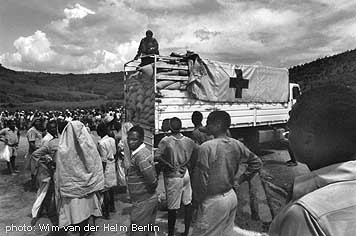
|
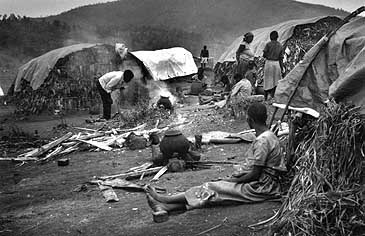 A
real problem is the lack of beans in the whole region. The distribution
so far consisted mainly of maize. which isn't the staple food of the Burundese;
fortunately they are now receiving half of the ration in form of flour. A
real problem is the lack of beans in the whole region. The distribution
so far consisted mainly of maize. which isn't the staple food of the Burundese;
fortunately they are now receiving half of the ration in form of flour. |
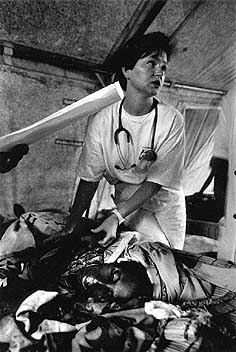 |
At current mortality rates, half the Burundian refugees in southern Rwanda could die from dysentery, malaria or malnutrition, according to Dr Rosamund Lewis of Medecins sans Frontieres Holland. 'The major problem stems from overcrowding, and we are also facing 25 per cent general malnutrition and 10 per cent severe malnutrition among children,' said Dr Lewis. 'Malnutrition in the camps is really much too high, and there's no point in giving medicine to an empty stomach. | |
|
|
|
|||
|
[start]
|
[e-mail]
|
||